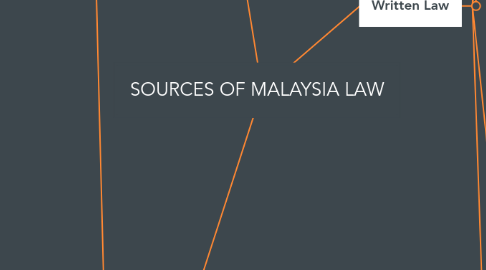
1. Islamic Law
1.1. Sacred law revealed through Holy Quran and Sunnah Prophet Muhammad (PBUH)
1.2. Sources of Islamic Law
1.2.1. Primary
1.2.1.1. Al-Quran
1.2.1.2. Sunnah
1.2.2. Secodary
1.2.2.1. Ijma
1.2.2.2. Qiyas
1.3. Head of Religion
1.3.1. 9 malay states
1.3.1.1. Sultan
1.3.2. Federal Territories (KL, Labuan & Putrajaya)
1.3.2.1. The Yang di-Pertuan Agong (YDPA)
1.4. Administration
1.4.1. Majlis Agama Islam
1.4.2. Mufti (highest religious official)
1.4.3. Syariah Courts
1.5. Syariah Court
1.5.1. Only talks about muslim
1.5.2. High Courts and Subordinate Court have no jurisdiction
2. Unwritten Law
2.1. English Law
2.1.1. Application
2.1.1.1. Abscence of local legislation
2.1.1.2. Cut off date
2.1.1.3. Suitable for local circumstances
2.1.2. Common Law
2.1.2.1. Body of rules or judicial decisions developed by the old common law court
2.1.3. Equity
2.1.3.1. Complain of harsh or inflexible rules of common law which prevented justice from prevailing
2.1.3.2. Based on a judicial assesment of fairness as opposed to the strict and rigid rule of common law
2.2. Judicial Decisions
2.2.1. Definition of decisions
2.2.1.1. Court's actual determination of dispute between parties (inter parte)
2.2.2. Ratio decidendi
2.2.2.1. Legal reasoning : Statement of law that has been applied to the issue of the particular case
2.2.3. Obiter Dictum
2.2.3.1. Statement of law made by a judge as an illustration of case.
2.2.4. Why we use judicial decision?
2.2.4.1. Foresee every potential dispute thus, some loopholes may occur in enacted law
2.2.4.2. Court is given the authority to expand the existing law to cover these loopholes
2.2.4.3. The words or phrase used in statutes are open to different and contradictory meaning
2.2.4.4. Court who will determine the correct and proper meaning of those words/phrases
2.2.5. Judicial precedent
2.2.5.1. Decision of superior court of law
2.2.5.1.1. Support of one's argument
2.2.5.1.2. Cited as an authority
2.2.5.1.3. To be adopted by a judge in making his decisions
2.2.6. Doctrine of stare decisis
2.2.6.1. States that where the facts are same/almost alike to the previous judicial decisions must be followed
2.2.6.2. Known as "Doctrine of Binding Judicial Precedent"
2.2.6.3. Rationale of doctrine
2.2.6.3.1. To standardized the law
2.2.6.3.2. To prevent uncertainty of law
2.2.6.3.3. To prevent injustice
2.2.6.3.4. To achieve consistency
2.2.6.4. Operation of doctrine
2.2.6.4.1. Operates according to hierarchy of the courts
2.2.6.5. Application of doctrine
2.2.6.5.1. Vertical
2.2.6.5.2. Horizontal
2.3. Customary Law
2.3.1. Personal laws which are applicable to a particular racial, religious or ethnic groups
2.3.2. enforce by courts and have a legal consequences on its breach
2.3.3. Customary Law of Malaysia
2.3.3.1. Malay
2.3.3.1.1. Customs relating to marriage, divorce and inheritance which are given legal force
2.3.3.2. Chinese
2.3.3.2.1. Creation of the courts of a uniform body of Chinese customary law applicable to all Chinese
2.3.3.3. Hindu
2.3.3.3.1. matter of polygamous marriage
2.3.3.3.2. joint family property
2.3.3.4. Sabah & Serawak
3. Written Law
3.1. Federal Constitution
3.1.1. Article 4 (1) - This Constitution is the supreme law of the Federation and any law passed after Merdeka Day which is inconsistent with this Constituyion shall, to the extent of the inconsistency be void
3.1.2. Federal System
3.1.2.1. YDPA is a constitutional head
3.1.2.1.1. Head of the Executive
3.1.2.1.2. Head of the Legislature
3.1.2.1.3. Head of hte Judiciary
3.1.2.2. Conference of Rulers
3.1.2.2.1. can dismiss the YDPA
3.1.2.2.2. electing the YDPA and the TImbalan YDPA
3.1.2.2.3. authority to appoint two out of the five judges on the special court
3.1.2.2.4. has the power to grant pardon, reprieve, respite, remission, suspension or commutation of the sentence
3.1.2.3. Organs of the Government
3.1.2.3.1. The Judiciary
3.1.2.3.2. The Legislative
3.1.2.3.3. The Executive
3.2. State Constitution
3.2.1. regulate the government of the state
3.2.1.1. The Ruler
3.2.1.2. The Legislature of the state
3.2.1.3. The Legislative Assembly
3.2.1.4. The executive council
3.3. Legislation
3.3.1. Law enacted by the legislature and by bodies and persons authorized by the legislature
3.3.1.1. Act
3.3.1.2. Ordinances
3.3.1.3. Enactments
3.3.2. Legislative Process
3.3.2.1. Pre-Parliamentary Stage
3.3.2.2. Parliamentary Stage
3.4. Subsidiary Legislation
3.4.1. known as Delegated Legislation, Secondary Legislation, or Subordinate Legislation.
3.4.1.1. YDPA
3.4.1.2. Ministers
3.4.1.3. Local Government Authorities
3.4.2. Advantages
3.4.2.1. save time for legislatures
3.4.2.2. technical experties
3.4.2.3. flexibilty and convenient
3.4.2.4. legislation can continue even not in sessions
3.4.3. Disadvantages
3.4.3.1. loss of legislative control
3.4.3.2. bulk and frequent changes
3.5. Statutory Intrepretion
3.5.1. Who need it?
3.5.1.1. Judges to decide civil cases and criminal cases
3.5.2. Why it is necessary?
3.5.2.1. Uncertainty
3.5.2.2. Broad terms
3.5.2.3. Bad drafting
3.5.2.4. Unforseeable developments
3.5.2.5. Vhanges in the use of language
3.5.3. Common Law rules
3.5.3.1. Rules of Statutory Interpretation
3.5.3.1.1. Literal Approach
3.5.3.1.2. Purposive Approach
3.5.3.1.3. Rules
3.5.3.2. Language Rules
3.5.3.2.1. Statute must be read as a whole
3.5.3.3. Internal & External aids to interpretation
3.5.3.3.1. Internal
3.5.3.3.2. External
